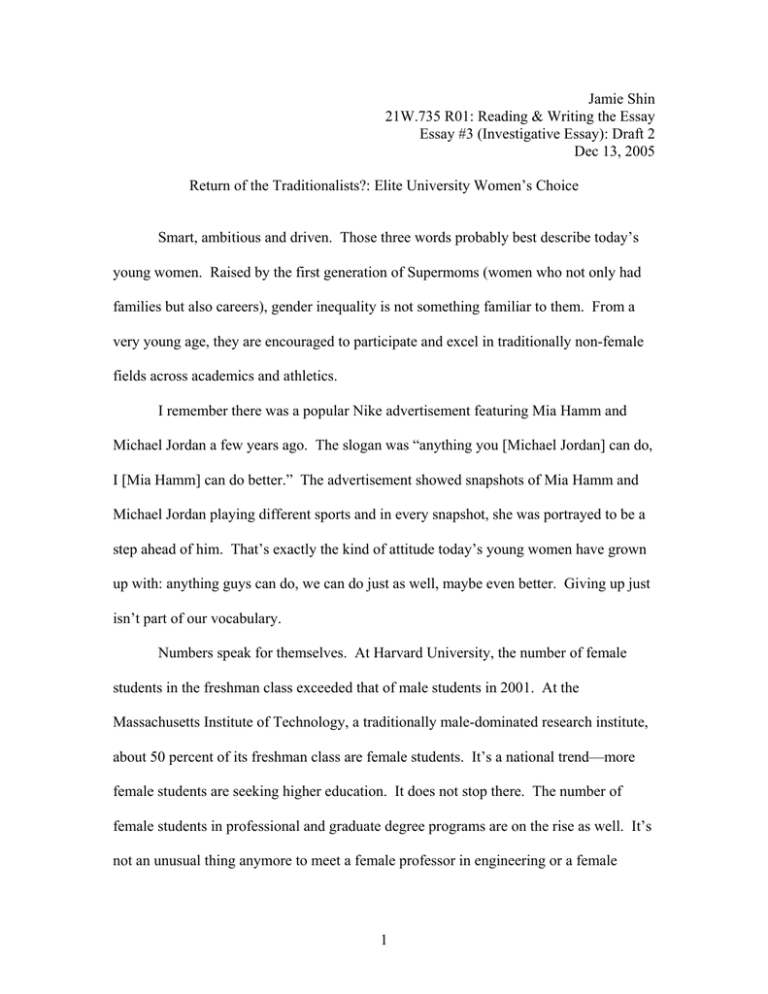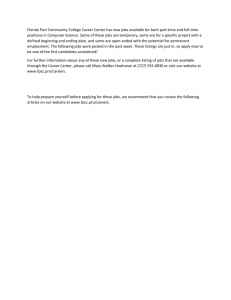Jamie Shin 21W.735 R01: Reading & Writing the Essay Dec 13, 2005
advertisement

Jamie Shin 21W.735 R01: Reading & Writing the Essay Essay #3 (Investigative Essay): Draft 2 Dec 13, 2005 Return of the Traditionalists?: Elite University Women’s Choice Smart, ambitious and driven. Those three words probably best describe today’s young women. Raised by the first generation of Supermoms (women who not only had families but also careers), gender inequality is not something familiar to them. From a very young age, they are encouraged to participate and excel in traditionally non-female fields across academics and athletics. I remember there was a popular Nike advertisement featuring Mia Hamm and Michael Jordan a few years ago. The slogan was “anything you [Michael Jordan] can do, I [Mia Hamm] can do better.” The advertisement showed snapshots of Mia Hamm and Michael Jordan playing different sports and in every snapshot, she was portrayed to be a step ahead of him. That’s exactly the kind of attitude today’s young women have grown up with: anything guys can do, we can do just as well, maybe even better. Giving up just isn’t part of our vocabulary. Numbers speak for themselves. At Harvard University, the number of female students in the freshman class exceeded that of male students in 2001. At the Massachusetts Institute of Technology, a traditionally male-dominated research institute, about 50 percent of its freshman class are female students. It’s a national trend—more female students are seeking higher education. It does not stop there. The number of female students in professional and graduate degree programs are on the rise as well. It’s not an unusual thing anymore to meet a female professor in engineering or a female 1 executive. I was also raised with this “anything they [guys] can do, I can do better” slogan. I have been a great follower of the trend. I went to a math and science magnet school and I am due to graduate with a degree in Economics from MIT. With a degree from an “elite” institution, I plan on going into something more competitive, fast-paced and maledominated: the corporate world. Like many other students with background in Economics or Finance, my choice of industry is investment banking: prestigious, notorious for the workload, and predominantly male—historically and concurrently across all levels. Until I started interviewing, I did not fully realize how male the industry is. In the recruiting process, I met more than a handful of interviewers—mostly junior to mid-level professionals in the industry. And only two of them were female; both first-year analysts, only one year senior to me. As I sat in the waiting area of the Career Services Center waiting for my interviews, I looked around the room. The gender ratio seemed pretty even, at least on the recruit level. If it starts out pretty even, close to 50:50, what happened to those “missing” women in mid-level management? If they grew up as ambitious and driven, where are they now, 10 years after graduation? Has “giving up” become part of their vocabulary once they left school? I wondered. In late September this year, I ran across an interesting article from the New York Times that answered my initial question but also raised more questions. After reading “Many Women at Elite Colleges Set Career Path to Motherhood” by Louise Story, the mystery was solved: the missing women are at home with children. “My mother’s always told me you can’t be the best career woman and the best mother at the same time,” Ms. Liu said matter-of-factly. “You always have to 2 choose one over the other.” There was the answer to my previous question. Because a choice had to be made, women choose to stay home. I did not like the answer. What about most fathers? Are they passing up on opportunities to be the best dads in order to be the best professionals? Why is it a choice for women when it is not for men? Is it really impossible to be the best parent and best professional at the same time? It seemed to be against everything modern feminists had fought for. What’s more disturbing is that many young, smart women make the decision to significantly (and negatively) alter their career path even before starting their career. Story did a survey of Ivy League college women, and about 30 percent of women surveyed said they planned to leave the workforce while their children were young, while another 30 percent planned to work part-time. Many students featured in Story’s article said that despite their high ambitions of earning advanced degrees and having highpowered careers, they are planning on sacrificing their career to have a family. Some may argue that there is no reason to be alarmed by what the survey is suggesting. What one thinks when she is in her late teens and early twenties isn’t necessarily the best indicator for what she will do later in life. However, it should be noted that expectations both reflect and influence the prevailing social and cultural norms related to gender roles. What’s causing these young smart women to make such important career decision without much hesitation? Historically, women had to fight for the right to higher education and access to fulfilling careers. When those are available, why are today’s young women walking away? Were the efforts of modern feminists futile? Altering one’s career is not a decision to be taken lightly. A study done by Pamela Stone and Meg 3 Lovejoy suggests that the cost of career interruption accounts for as much as one-third of the gender gap in earnings. Despite the steep cost, women with higher education are out of the labor force at a rate roughly 3 times that of their male counterparts. Many women are leaving the work force in their 30s, the prime time for their career development, despite their ambition and achievement. It’s a loss not only for those women but also for the younger generation, whose expectations are heavily influenced by the cultural norm set by those ahead of them. In 1980, there was a similar article on the New York Times titled “Many Young Women Now Say They’d Pick Family Over Career.” Over three-fourths of women then said mothers should either not work or only work part-time until their children were 5 years old. The majority of men agreed. In Story’s survey, 25 years later, roughly 60 percent of women answered that they are planning on altering their career for family. Only two participants in 2005 answered that they “expected their husbands to stay home with the children while they pursued their careers.” Only two more answered that the decision would depend on whose career was furthest along. Despite women’s achievement and the social changes that took place over the past 25 years, the landscape has not changed much. In Lovejoy and Stone’s study that took place in 2004, 60 percent of women that quit their flourishing careers said their husbands were one of the key influences on their decisions to quit. Women in high-profile careers are likely to be with men in professional jobs much like their own, with long hours and extensive travel. For this reason, many women feel a lack of support from their husbands. “He always said to me, ‘You can do whatever you want to do.’ But he’s not there to pick up any load,” said Kristen Quinn in 4 an interview with Lovejoy and Stone. Despite the high-powered nature of their own careers, the majority of women do not explore the idea of their husbands cutting back. Instead, they implicitly accept that their own career was secondary. Despite their previous proactiveness in academics and professions, women seem to be turning surprisingly passive. They are more educated and living in a more progressive era, but those women are new traditionalists in a sense that they accept child rearing as women’s primary responsibility. Regardless of her success, a woman’s career is not taken as seriously in the society. While it is unacceptable for a man to interrupt his career even for a brief time period, it is almost expected for a woman. For example, as Mary Blair-Loy and Amy S. Wharton point out in their study of working parents, men are extremely unlikely to take parental leaves, though it is officially available. For women, a career is still seen as “something to play with” until she can replace it with children, while it is seen as source of lifetime satisfaction for men. There’s a dissonance between what’s taught in school and what’s practiced outside of school. In school (atheletics and academics), women are encouraged to explore and develop their abilities to full potential. The support is disconnected once women march out the school gate with their diplomas. As daughters, they were expected to live life to the fullest. Once they become wives and mothers, their self-fulfillment becomes less important: they are expected to function as support roles only. Corporate culture is another factor shaping women’s decision to quit. Women with elite educations pursue high-powered careers, which are often seen as “all or nothing.” By nature, the work schedule is highly unpredictable, with last-minute 5 business trips and unexpected late nights. As an anonymous participant in Stone and Lovejoy’s study describes it, “high-tech work week is really sixty hours, not forty.” Many women are employed in settings where the pace and expectations were set by men with stay-at-home wives who handle everything outside of work. Corporate culture has evolved to be less family-friendly. The face time in the office is much longer than it used to be. With thanks to improvement in transportation, business travel is much more frequent. Even when parents are at home with children, they are never away from work—there are e-mails, cell phones, and blackberrys. There’s no life outside of work. Work is life. Due to the “all or nothing” nature of the work, many women view their options as either working forty-plus hours a week or quitting. There is an alternative. Between a forty-plus week job and a full-time motherhood, there is a part-time job. By definition, it is an excellent idea. Women can have both—a fulfilling career and a rewarding motherhood—at a certain price. Unfortunately, it is not even an option for many professional women. According to Stone and Lovejoy, 40 percent of women who tried to reduce work hours were denied. Even when one is lucky enough to work part-time, there is a dilemma. Working part-time in jobs that were effectively full-time make many women feel inadequate. The nature of having a parttime career limits their career progression. Working part-time is often seen as a sign of “lack of commitment” and they are excluded from more interesting and engaging work. Working part-time often does not meet their high standards and they end up putting in more hours. Is it really elite women’s “choice” to stay home? Not if it is a forced decision. They are not making a free choice because they don’t have the kind of institutional 6 arrangement and social understanding that would make a truly free choice possible. Structural support exists in name only. A high-profile career has become more and more demanding, to a point if one wants to be successful, work must take up every single minute of one’s life. Cutting back time or working flexible hours to spend time with children is seen as lack of commitment to one’s career. There are parental leaves and dependent care programs supported by employers, but using those policies are often negatively correlated with one’s career progression. Under such circumstances, having it all is actually halving it all: a stressful career that is going nowhere and “industrial-size helpings of maternal guilt,” as Katha Pollitt puts it in a column in The Nation. Lack of institutional support is not the only obstacle women have to tackle. There is also lack of emotional support from their partners and the society as a whole. The society supports young girls to be ambitious and adventurous. However, as they get older, the support is suddenly gone. Instead, they are told by the society that their professional satisfaction and fulfillment are not that important. Given the current lack of structural and emotional support, it is not surprising that professional women are exiting the labor force 3 times as fast as men. What about young women’s pre-planned career interruption? Is that also a choice? Is that a well-thought-through decision? It’s a well-informed, forced choice. Women who make the decision are aware of the price they will have to pay under the current system if they want to have it all. They are not neo-traditionalists. They are just picking up mixed signals. School and parents teach them that they can do anything they want to do but at the same time, they see the struggles of their alumnae, once ambitious and smart like themselves. Their opinions are nothing new or surprising. They are just reflecting 7 the current cultural norm. They are not to be blamed for giving up too early. What’s to be blamed really is the inflexibility of the corporate culture and of the current gender roles in the family. Note__________________________________________________________________________________ The works cited in this essay include: “Many Women at Elite Colleges Set Career Path to Motherhood” by Louise Story. The New York Times. September 20, 2005; “Despearate Housewives of the Ivy League?” by Katha Pollitt. The Nation. October 17, 2005; “Mothers in Finance: Surviving and Thriving” by Mary BlairLoy and Amy S. Wharton, The Annals of the American Academy. November 2004; “Fast-Track Women and the ‘Choice’ to Stay Home” by Pamela Stone and Meg Lovejoy, The Annals of the American Academy. November 2004 ; and “Many Young Women Now Say They’d Pick Family Over Career.” by Dena Kleiman. The New York Times. December 28, 1980. 8


